with hamster modifications by Linda Price
Type Defined
According to the American Heritage College Dictionary, type is defined as “An example of a model having the ideal features of a group or class.” Thus, when we discuss a particular animal’s “type,” we are comparing its physical features to an imaginary ideal. A detailed description of this ideal image can be found in the hamster standard. (The CHA uses the BHA standards.) The standard is meant as an ideal guide, which all breeders should strive to come close to meeting.
Usually, when discussing type, fanciers are referring to the way an animal is put together (its conformation). This includes its head shape and size, eye and ear placement and size, length and shape of body, and amount of bone. An animal who is put together in a way that comes close to that described in the standard is considered to have good type (or you can say it is “typey”). An animal that does not look like what the standard describes would be considered to have “poor type” or be “lacking type.”
The Standards
When you read the hamster standards, it quickly becomes clear what show hamsters are supposed to look like. Remember though . . . the standard is considered an almost unreachable ideal. The closer to it the hamster is, the higher a judge will place them at a show.
BHA Syrian Hamster Standard
Type (25 points)
The body shall be broad and cobby. The head shall be large in proportion to the body with a broad skull, short face and blunt nose. The head shall be well set into the body, the profile showing a smooth curve from nose over head, to nape of neck.
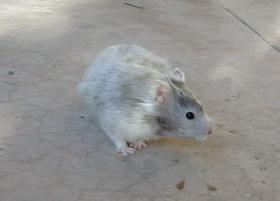
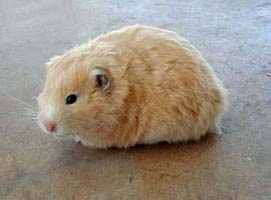
This long haired syrian also has a good, thick coat which hides some of her body shape. A short haired syrian should also have a thick coat, but the body would appear less "fat."
The fur shall be soft and very dense. Special attention shall be paid to the density of the belly fur. In Short Haired hamsters the fur shall be very short and even. In longhaired hamsters, allowance must be made for sex; i.e. males must have longer fur than females. Matting will be heavily penalised.
Size (10 points)
The hamster shall be as large as possible but not too fat. Allowance shall be made for sex; i.e. female hamsters in general are larger than males.
Condition (10 points)
The hamster shall be fit, alert when well awake and tame to handle. The flesh shall be firm with no surplus fat. The coat shall have a healthy sheen and the hamster shall be clean and show no signs of injury
Eyes and Ears (5 points)
The eyes shall be large, prominent and widely set. The ears shall be whole, large, rounded, set well apart and carried erect and unfolded when the hamster is awake.
(PLEASE NOTE THAT ALL REFERENCE TO COLOUR OF FUR, EYES AND EARS IS SO FAR OMITTED.
Colour and Markings (30 points)
For patterned hamsters 15 points shall be allocated for colour and markings and 15 points for pattern.
Where base colour is indicated this applies to the whole animal.
Eye Colour
The following sequence of eye colours shall apply in increasing order of darkness:
1. Bright clear pink
2. Red
3. Claret Red
4. Claret
5. Ruby
6. Garnet
7. Dark Brown
8. Black
BHA Dwarf Hamster Standard
Overall Type and Build (25 points)
The build should be broad and cobby, with the head set well into the body. The head should be broad and short with a blunt nose and the legs and tail both short and scarcely visible. Eyes should be set well apart and be rounded, but should not bulge. Ears should be small and rounded, yet show above the fur; the insides to be a little hairy.
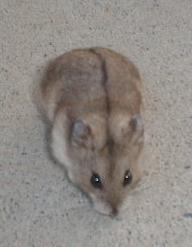
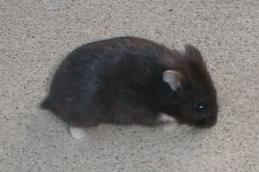
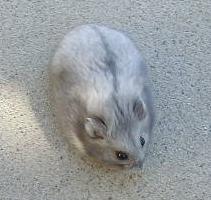
Ideal adult range 10-12 cm
Fur (20 points)
The fur should be short and dense with a very thick undercoat. The soles of the feet should have dense fur.
Condition (10 points)
The hamster should have a lively image with clear bright eyes. Overweight animals to be heavily penalised
Colour and Markings (30 points)
For patterned hamsters 15 points shall be allocated for colour and markings and 15 points for pattern.
Where base colour is indicated this applies to the whole animal.
Why Is Type Important
You may be asking “Why on earth does it matter how a hamster is built.” Admittedly a pet hamster can be put together in any of a thousand ways and still be a great pet. Type plays an important part in the soundness of a hamster. An animal that is not put together in a structurally sound manner may develop health problems.
Of course, a typey animal is also a pleasure to look at and to watch move. If you show hamsters, type becomes doubly important still simply because 25% of what it is judged on is its type. Color and markings make up another 30%, while other factors make up the final 45%.
Breeding For Good Type
Breeding for good type is very important — and potentially more difficult than breeding just for good color and markings. A breeder who produces an animal that has the expected nice temperament and good health, as well as excellent color, markings, and type, has truly reached the ultimate goal of all fanciers. This is when breeding animals goes far beyond just a science and becomes a true art form.
Unfortunately, breeding good type is not simple. Unlike color and markings, type is not controlled by a small handful of genes. Instead, many are involved. Each part of the animal is usually determined separately, thus an animal with beautiful eyes and ears may have a very poor head.
The first step in breeding for good type is to take a serious and unbiased look at your own animals. What are their faults, and can you see problems that have been passed down through the generations. You also need to know your animal’s strong points. In what ways do they (and their whole family) excel.
A good way to find these things out is to take your animals to shows. Not only can you get the judge’s opinion on your animals, but you can ask other fanciers as well. Just remember, when you ask someone’s opinion, that’s just what you are likely to get. Opinions can vary greatly. Use what is helpful, and throw out that which is not. Don’t take it personally when someone comments unfavorably on your animal — remember, you asked!
Once you know the strong and weak points of your own animal's type (and other characteristics), you can go in search of the “perfect” match. You want to find an animal with color and markings complementary to yours who excels (and whose family excels) in all those areas where yours do not.
When you breed this animal to yours, don’t expect miracles. Often you will get a mishmash of non-uniform babies. With some careful selection, however, you should be able to find a male and a female who between them have all the qualities you are looking for. Breed these together and in most cases you will get several babies who are a definite improvement over your original stock. You may also get some who have the worst of all features (luck usually dictates that these are the ones with the best color/markings) so selection is always very important.
To top this all off, I will admit that there is most definitely an element of luck involved in breeding for type. I have seen a number of animals with beautiful type come out of pet shops, and seen breeders produce poor type out of breedings involving animals who are beautiful.
Breeding Is Just the Beginning
The old adage among animal breeders is “First you have to breed them right, then you have to feed them right.” This applies to hamsters as well as all other animals.
Even though an animal may have the potential for beautiful type, if it does not receive the proper care it will not reach that potential. This starts with the health and care of your females before they are ever bred. It includes her care and feeding throughout the pregnancy, and while raising those babies. From weaning on, all external factors including feeding, housing, bedding, handling, etc., play a part in how that baby is going to turn out.
So there you have it. Type is simply the way a hamster is put together. The hamster standards set the “ideal” type by which all animals are measured. “Typey” hamsters come close to meeting the standard; those with poor type do not. Breeding for good animals can be difficult, frustrating, and sometimes seems darn near impossible. Producing that beautifully typey hamster, however, can be one of the high points in any breeder’s time in the fancy.
Reprinted with Permission from the American Fancy Rat and Mouse Association (AFRMA) web site at www.afrma.org.